If you are looking for bird friendly trees and shrubs a database has been created that can help. The Audubon Native Plants Database allows you to enter a zip code and get a list of bird friendly native plants. You can filter based on plant type and what type of bird the plant attracts. The database also shows what kind of birds favor particular plants.
Silviculture Handbook Users: Complete survey by June 22
By Carmen Hardin, Applied Forestry Bureau Director
We are inviting all users of the WDNR’s Silviculture Handbook to complete a survey to gather input on how they use the handbook and suggestions for improvement in structure, format and information.
Please complete the survey at https://www.surveymonkey.com/r/VQGTJZQ by June 22, 2018.
This survey request is driven by several factors. The primary need is that the Department of Natural Resources, working with the Silviculture Guidance Team, recognizes the need to take a holistic review of the structure and format of the handbook in an effort to address concerns raised in the Wisconsin Forest Practices Study and by other key users, and to improve overall communication of important silviculture concepts. A goal of this review is to evaluate the organization and presentation to improve the utility and function for handbook users.
This survey request also ties into continued efforts to gain efficiencies to meet the 20,000 hour reduction in investment in forest tax law program administration. The Division of Forestry’s Tax Law Section is looking to move key eligibility and enforcement requirements into the Tax Law Handbook and rely more on the Silviculture Handbook as a resource, similar to the Best Management Practices for Water Quality Field Manual, the Biomass Harvesting Guidelines and guidelines related to forest health issues.
The survey has 23 questions and should take approximately 15 minutes to complete. Please share this survey request with others that you think may be interested in completing it.
If you have questions regarding the survey, please contact Katy Thostenson at 608-535-7049 or kathryn.thostenson@wisconsin.gov.
Forestry partners take lead in 2018 EAB trapping
By Paul Cigan, forest health specialist, Hayward. Paul.Cigan@wisconsin.gov; 715-416-4920
As summer approaches, adult emerald ash borer (EAB) beetles are beginning to emerge to feed and reproduce.
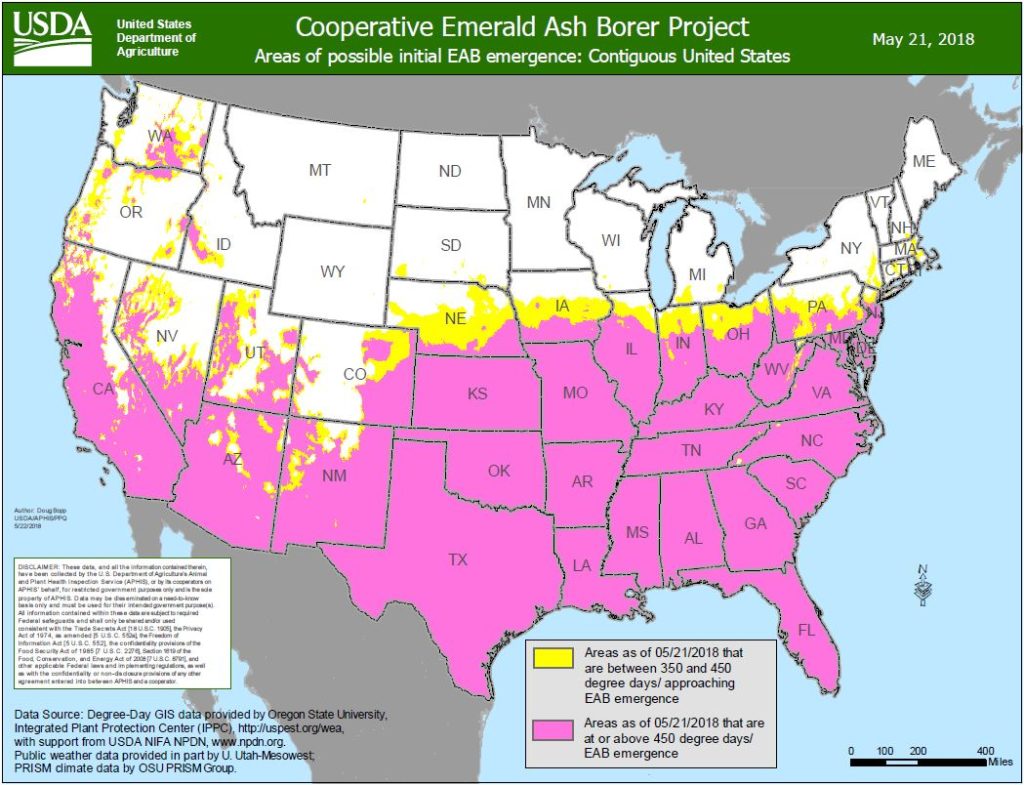
USDA APHIS EAB emergence map. Map credit: USDA Cooperative Emerald Ash Borer Project
Due to the recent statewide quarantine for emerald ash borer and workload considerations, USDA’s Animal and Plant Health Inspection Service, Plant Protection and Quarantine (APHIS PPQ), the Wisconsin Department of Agriculture, Trade and Consumer Protection (DATCP), and the Wisconsin DNR Forest Health Program have discontinued trapping programs for adult beetles in Wisconsin. Continue reading “Forestry partners take lead in 2018 EAB trapping”
Eastern tent caterpillar and control options
By Linda Williams, forest health specialist, Woodruff. Linda.Williams@wisconsin.gov; 715-356-5211 x232
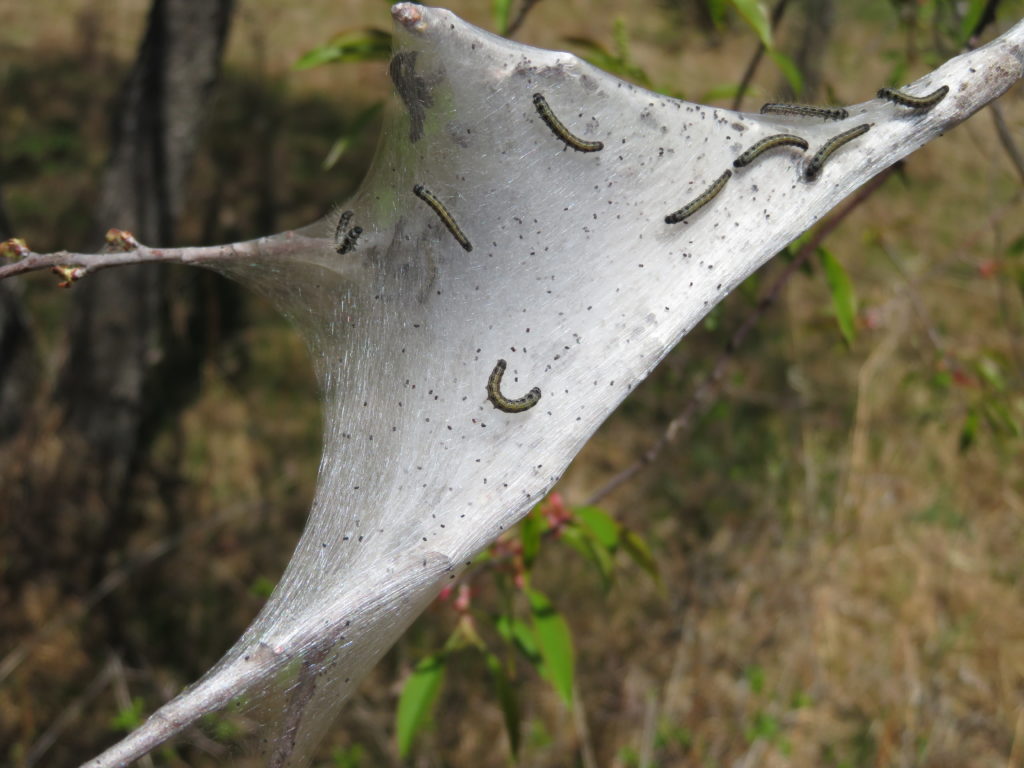
Young eastern tent caterpillars on their web nest. Photo: Linda Williams
Winter is finally over and eastern tent caterpillars are hatching and building their web nests! In northern Wisconsin, the caterpillars began hatching in early to mid-May, but they emerged earlier in southern Wisconsin. Webs will become larger as the caterpillars feed and grow. Continue reading “Eastern tent caterpillar and control options”
Forest tent caterpillar: surveys, prediction, and history
By Paul Cigan, forest health specialist, Hayward. Paul.Cigan@wisconsin.gov; 715-416-4920
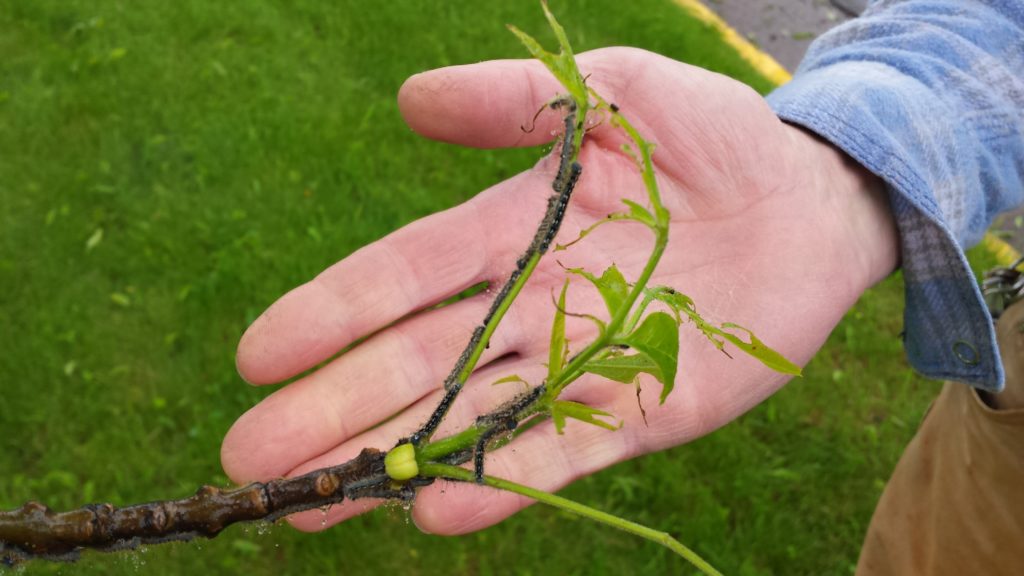
Forest tent caterpillar larvae feeding on ash foliage. Photo: Paul Cigan
Late-winter surveys in northern Wisconsin for egg masses of forest tent caterpillars (FTC) suggest that numbers will remain low through 2018, continuing a 15-year trend, one of the longest documented intervals between FTC outbreaks in the state. Continue reading “Forest tent caterpillar: surveys, prediction, and history”
Trapping for non-native beetles
By Mike Hillstrom, forest health specialist, Fitchburg. Michael.hillstrom@wisconsin.gov; (608) 513-7690
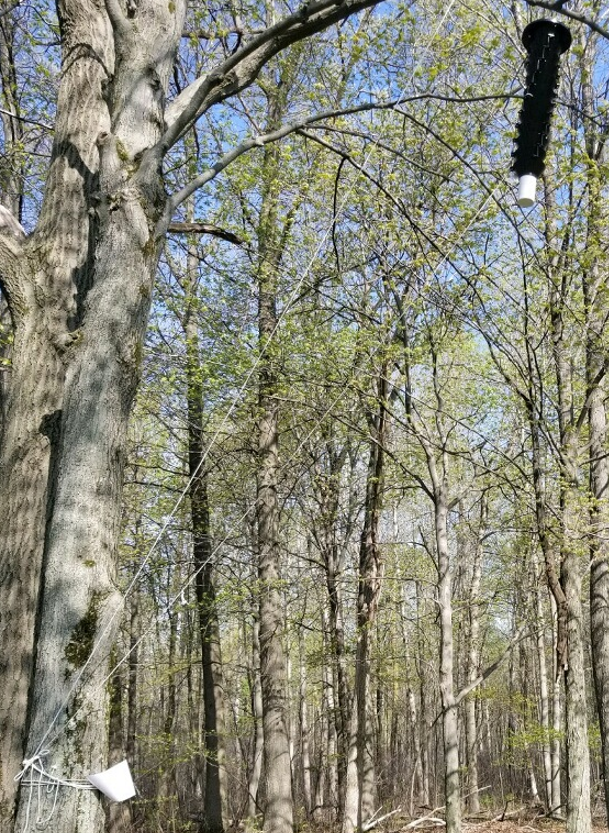
A Lindgren funnel trap hung to collect beetles near Green Bay, WI. Photo: Mike Hillstrom
Scott Schumacher, an insect trapper for the Wisconsin DNR’s forest health team, will spend this summer hunting for non-native beetles using funds provided by the U.S. Forest Service. The survey is particularly focused on non-native bark and ambrosia beetles, which are potentially harmful to Wisconsin forests. In early May, Schumacher hung Lindgren funnel traps at 12 sites in Wisconsin which he will be checking throughout the season. Traps were placed at high-risk sites in wooded areas near large commercial port entries on Lake Michigan and near pallet and other waste-packaging recycling companies. Although preventing the arrival of non-native species is always top priority, early detection and rapid response (EDRR) to newly-detected infestations is an important strategy to protect forests from damaging invaders.
Ladybugs in your house this spring?
By Linda Williams, forest health specialist, Woodruff. Linda.Williams@wisconsin.gov; 715-356-5211 x232
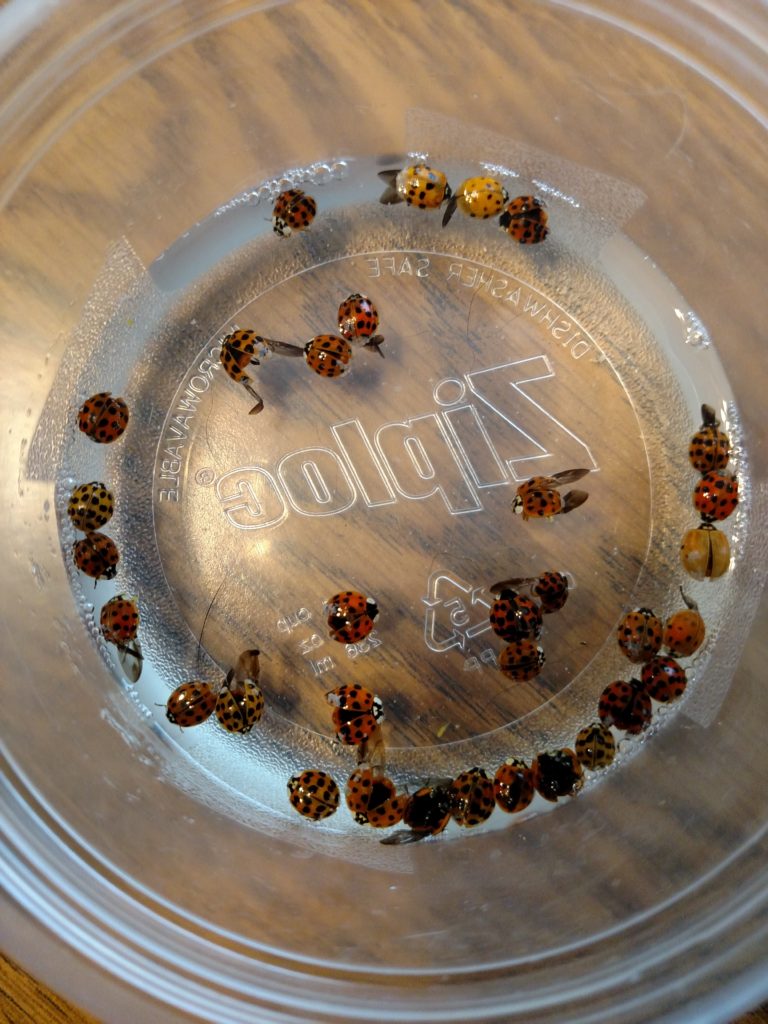
One option for removal of ladybugs from your home is to flick them into a small container containing soapy water, which will kill them. Photo: Linda Williams
In the December 2017 edition of Forest Health News, I wrote about ladybugs congregating in or on homes during autumn. Now that winter has finally ended in Wisconsin, ladybugs that spent winter in the walls of your house are emerging, and many of those will accidentally emerge into, not out of, your home. This can create panic or aggravation, depending on you (or your spouse’s) tolerance for insects in the house. Continue reading “Ladybugs in your house this spring?”
Defoliation by larch casebearers
By Linda Williams, forest health specialist, Woodruff, (Linda.Williams@wisconsin.gov), 715-356-5211 x232
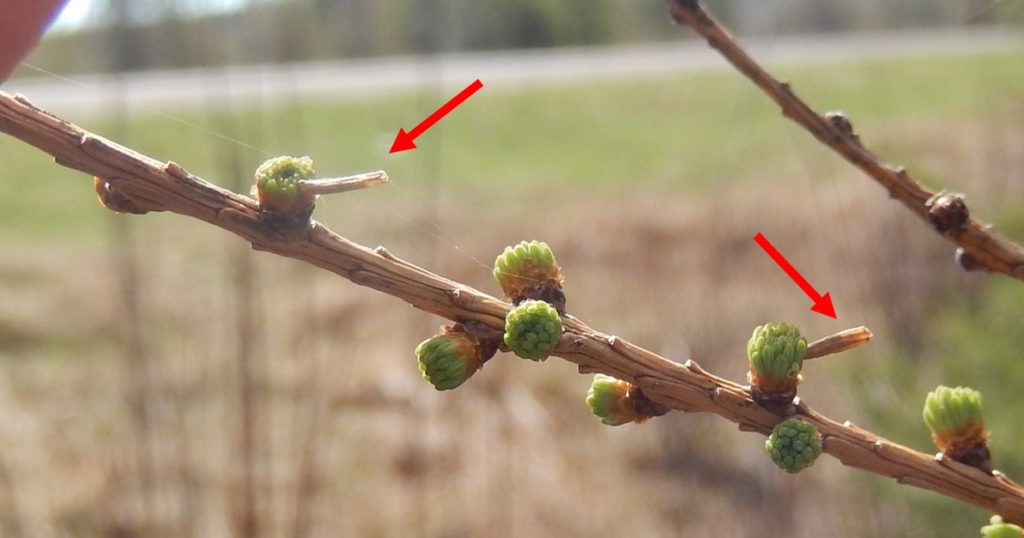
The two cigar-shaped, tan objects sticking to the newly expanding needles of this tamarack tree are larch casebearer caterpillars, feeding on the foliage. Photo: Linda Williams
As tamarack needles begin to appear, so do some tiny caterpillars that feed on them. Larch casebearers defoliate tamarack trees early in the season, first causing the trees to look pale green or yellowish, or even brown if defoliation is severe. This year I have been able to find larch casebearers wherever I look, but so far, I haven’t found any high populations of the insect. Continue reading “Defoliation by larch casebearers”
Tree mortality in low areas
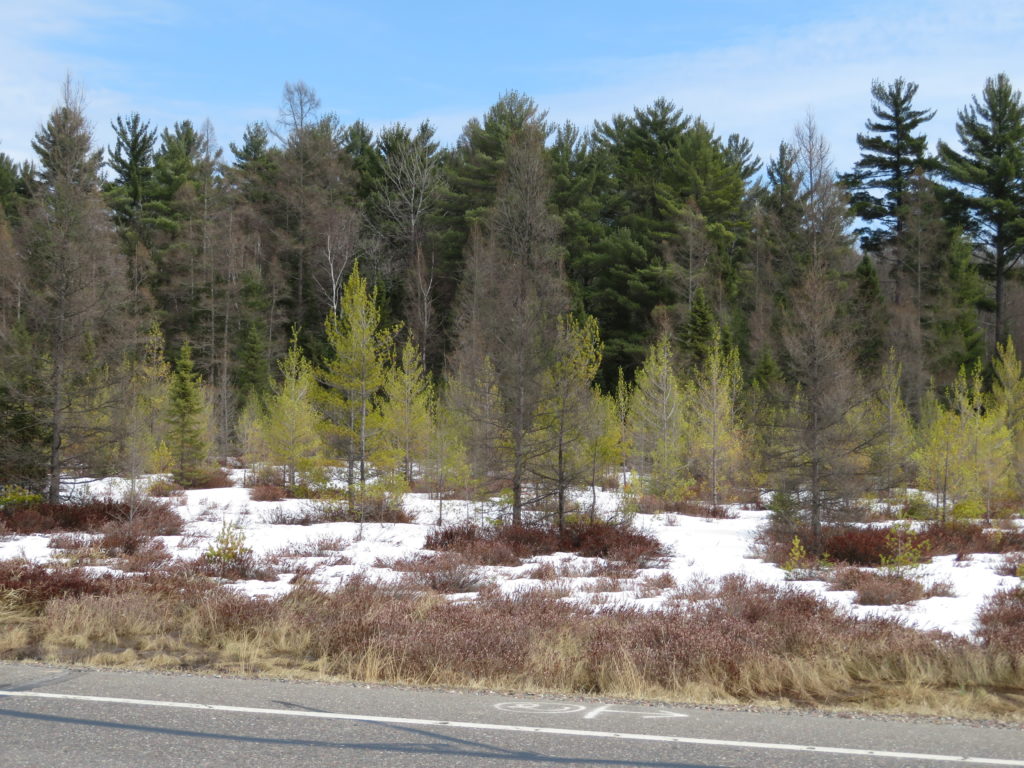
Trees have grown in this low area for many years, but high-water levels and constant rainfall in 2017 was too much for them. The larger trees have already died, and the small white pine are not doing well at all. Photo: Linda Williams
By Linda Williams, forest health specialist, Woodruff. Linda.Williams@wisconsin.gov; 715-356-5211 x232
I continue to get calls about dying trees that are a direct result of all the rainfall we got throughout last year’s growing season. When the ground is saturated so many times throughout the growing season as we saw last year, trees are put under significant stress. Even trees that typically grow well in seasonally wet areas may not do well when the ground is wet for extended periods. Under these conditions, roots start to die due to lack of oxygen, and the crown of the tree will also die back. Continue reading “Tree mortality in low areas”
Region-wide needle tip browning on red pine
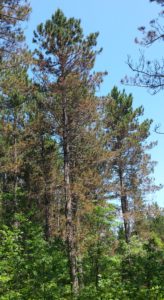
Red pine with needle tip browning on the lower crown. Photo: Paul Cigan
By Paul Cigan, forest health specialist, Hayward. Paul.Cigan@wisconsin.gov; 715-416-4920
Although no tree mortality is associated with the condition, widespread needle tip browning on red pine has been observed for the second consecutive year across much of the upper Great Lakes region. The condition is heavier in some places than others, but once in a stand or location, tends to be evenly distributed. Needle tip browning is common on the lower half of mature red pine crowns. On two- to three-year-old needles, the outer half to three-quarters of the needles appear reddish brown to straw-colored while needle bases remain green. Black or dark brown necrotic bands and spots are often present on symptomatic needle tips. Lower crown thinning is also common on symptomatic pine. Newly impacted needles will gradually lighten in color from reddish brown to straw-colored as dead needle tips dry out through the growing season. Continue reading “Region-wide needle tip browning on red pine”
